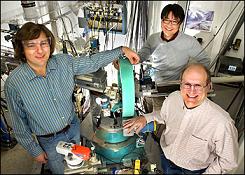A team of researchers at the U.S. Department of Energy’s Brookhaven National Laboratory have found that thin molecular films continue to be in a frozen state at a temperature where the bulk material is in the molten state.
These molecules in thin films are deployed in several applications like organic solar cells and biosensors and perceiving the basic features of these molecular films could bring about enhanced devices.
 Brookhaven National Laboratory Researchers
Brookhaven National Laboratory Researchers
The research was published in Physical Review Letters’ April edition and the researchers directly perceived ‘surface freezing’ phenomenon at the hidden layer between solid surfaces and heavy liquids.
Ben Ocko, Physicist at Brookhaven, worked with researchers from France-based European Synchrotron Radiation Facility (ESRF) and Israel-based Bar-Ilan University. He has stated that the surface of most of the materials will begin to disarray and ultimately melt at a particular temperature where the bulk material remains to be in a solid state. Because outer molecules are less constricted than those molecules that are filled in the inner layers and they can easily travel around. He added that in surface freezing, the interface layers freeze before the bulk material.
In the beginning of 1990, two research teams observed surface freezing in bulk alkenes’ vapor interface. Later it was observed in several interfaces between molecules of simple chains.
Recently, the scientists found that surface freezing also happens at the layer between a solid surface and a complex liquid. They established contact between a highly polished sapphire material and liquid alkanol under temperature-regulated conditions at Brookhaven’s National Synchrotron Light Source and the ESRF. An x-ray beam of high intensity was passed through the interface and the reflecting pattern of x-rays was determined. When compared to other molecules in the bulk liquid, the alkanol molecules showed different behavioral pattern at the surface of sapphire material.
Diego Pontoni, ESRF scientist, has stated that the alkanol molecules develop a precise frozen monolayer at the sapphire layer at a temperature where the bulk alkanol remains in the liquid state. He added that the frozen monolayer melts at suitable higher temperatures, i.e. around 30°C above the bulk alkanol’s melting temperature.
The range of temperature, above which the monolayer prevails, is around 10 times higher than what is noticed at the similar materials’ interface between liquid and vapor. Alexei Tkachenko, a theoretical physicist at Brookhaven’s Center for Functional Nanomaterials, has stated that the temperature range of the frozen monolayer and its thickness can be better explained by their newly developed model. He mentioned that the layer on the surface does not freeze suddenly like ice or crystals and a smooth alteration happens over a broad range of temperature.
Ben Ocko mentioned that these films are finer and better arranged when compared to all organic monolayer films developed till date. He added that the outcomes of this research and the hypothetical concepts may offer innovative ideas in the development of error-free, individual molecule-thick films.
The project was sponsored by the U.S. Department of Energy’s Office of Science and the U.S.-Israel Binational Science Foundation.
Source: http://www.bnl.gov